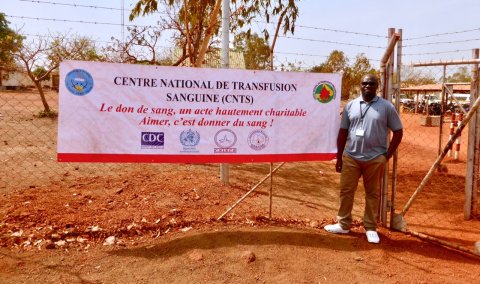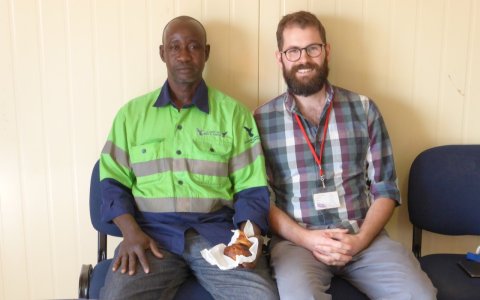Blood donation and public-private partnership in Mali

Mali’s sunburned, Sahelian capital city, Bamako, is home to almost two million people, 11,000 United Nations peacekeepers and the country’s national blood bank.
In fact, the Malian transfusion service, the Centre National de Transfusion Sanguine (CNTS), has never functioned as a blood storage bank – what comes in each day, goes straight back out.
The CNTS is typical of other west African national blood services: overstretched, under-resourced and, most importantly, lacking in blood. However, six hours south of Bamako a public-private collaboration between my place of work and the CNTS aims to reduce this deficit, in one of the first projects of its kind in Mali.
First forays into transfusion science
The 17th century saw the first forays into transfusion science, with experiments initially involving transfusions between pairs of dogs. 150 years later, in 1818, the first successful transfusion of human blood was used to treat a case of postpartum haemorrhage.
Since then, research and practice has evolved immeasurably with 35,000 units of whole blood now collected each week in the UK. In comparison, the CNTS in Bamako report that on a good day, approximately 15 volunteers might visit to donate blood.
These units, alongside additional ones donated by family and friends to loved ones in need, are used to treat obstetric haemorrhage, severe anaemia and trauma, among other conditions. However, with a daily demand far exceeding this, the country is left with a Sahara-sized hole that it is struggling to fill.
Challenge to increase the number of donors
Expanding the pool of donors isn’t easy and there are a range of challenges that must be overcome to increase the volume of volunteers and ensure they return to donate regularly.
Tanya Zanin’s 2016 literature review explores the mind-set of the sub-Saharan donor and identifies a number of key barriers to donation. These include perceived negative health consequences for the donor, including fever, weight loss and hypertension, all of which all are incorrect beliefs.
Further concerns stem from ideas that donated blood will be used for witchcraft, sold or that behavioural traits may be passed between donor and recipient.
On the other hand, she also highlights widespread motivating factors centring on altruism and collectivism, feelings that most of us can relate to. While blood transfusion is a keystone treatment in a number of conditions, it also has the potential to pass on blood-borne diseases, such as HIV, with devastating consequences.
International pressure to increase voluntary donations
In an effort to improve the safety of blood transfusion worldwide, the World Health Organization (WHO) has urged all countries to obtain blood exclusively from voluntary, non-remunerated donors by the year 2020.
Voluntary donors are seen as the cure for Africa’s blood banks for two main reasons; they are considered to have the lowest rates of transfusion transmissible infections and are thought more likely to donate regularly, crucial for maintaining reliable supplies.
However, the imposition of such policies, by the WHO and other agencies, grew out of experience in high-income countries, where blood supplies are furnished entirely by voluntary donors. In contrast, in 2010 less than 9% of blood collected in low-income countries came from voluntary donors.
Moreover, recently these views have been challenged with studies suggesting that the rates of transmissible infections are no lower in voluntary donors and that such reliance increases the cost of a unit of blood by two to five times, putting blood transfusion services under great financial stress and necessitating a reliance on external funding.
Impact of Western model of voluntary donors and centralised blood banks
In a 2012 paper, Fereydoun Ala et al reflected on the effects of such financial aid as well as the introduction of a Western model of voluntary donors and centralised blood banks.
They suggest the higher costs of voluntary donors stem from the costs to recruit and retain them and offer two further reasons for why the model is failing.
First, in contrast to high-income countries where the majority of blood products are used for planned, elective procedures, in sub-Saharan Africa over half of transfusions are administered in emergency situations, not surprising considering 99% of the world’s annual maternal deaths occur in developing countries.
Second, transfusion services in high-income countries split donated blood into individual components products, allowing the treatment of rare conditions such as haemophilia. However, in countries where the vast majority of blood is needed for acute emergencies, not only is whole blood potentially a superior clinical intervention it is also cheaper and faster.
Partnerships needed to improve donation rates

Clearly, African transfusion services and the nations, organisations and charities that support them need to consider novel ways to improve donation rates and generate sustainability.
This is where our story begins. In the southwest corner of the country, on the Guinean border, we are engineering a new model of support, helping to build capacity within the national system.
“Ever since I first visited [Mali] and met the local people I’ve known we can give back and improve things. To do this, I realised I needed to surround myself with people who had the skills and experience to make it a reality”, Hummingbird Resources CEO Dan Betts.
To do this, healthcare provision at the project was subcontracted to Critical Care International. We provide healthcare services to clients operating in remote and inhospitable locations, while also helping the company deliver evidence-based community development projects.
Private-public partnership and pooling resources
A partnership with the CNTS was first muted in late 2017. While discussing the development of an HIV project, Dr Ndane suggested that the national transfusion service was one of the Bamako organisations with access to HIV testing. Cameroonian born, Dr Ndane is a quietly spoken occupational health physician who has worked closely alongside Critical Care International since deployment.
He spoke with CNTS and enquired whether they may wish to collaborate on a future donation campaign at the mine site. They were immediately on board and even slightly incredulous, having rarely had anyone proactively approach them with an offer of assistance.
The details were quickly agreed upon. We would host a team of five people for four days, organise an education and publicity campaign and prepare areas for donation to take place.
In contrast, if a national transfusion service were to plan such a campaign alone, in a remote part of the country with poor infrastructure and a population unaccustomed to donation they would face a range of time and money consuming challenges. Transport would need to be organised, donation locations prepared, and electricity and fridges procured to store the blood, all at great cost.
In a similar vein, if the mine wanted to organise their own donation campaign they would need to hire and train staff and buy equipment to store, test and group the blood. Only then could they consider donating it to local hospitals.
In contrast, a partnership of this nature allows the two parties the chance to offer each other the resources for which they are specialised in.
Next round of donations already planned
While the team were on site, 151 units of blood were donated, far exceeding expectations and equivalent to ten days of volunteer donations from Bamako’s 1.8 million residents.
Both parties have been in contact since and the next round of donations planned for three months’ time, the minimum interval mandated between individual donations.
It can’t come soon enough for some; the medical team have spoken to many workers asking when the team will be back and looking forward to supporting the partnership in the coming years.
Expandable model
This model is easily expandable throughout Mali, sub-Saharan Africa, and other resource-poor regions of the world.
For instance, if each of the 11,000 UN soldiers and staff stationed in Bamako donated only a single unit of blood a year, it would triple the voluntary donation volume overnight and help stop mothers dying during childbirth, children dying from anaemia and sons and daughters dying from the effects of trauma.
It’s clear that although this is only a single project, pooling resources, sharing knowledge and public-private collaboration is certainly an efficient way of starting to deal with Mali’s blood problem.